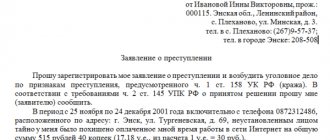Property damage report is a document that records damage caused to inventory items belonging to the enterprise. In this case, the intentionality or unintentionality of the actions that caused the damage to the property does not play a role - the act is drawn up regardless of these circumstances.
- Form and sample
- Free download
- Online viewing
- Expert tested
FILES
Examples of property damage acts:
- when an apartment or office is flooded - when performing any work - when delivering or transporting goods - namely documents
Why is the act needed?
The report refers to the primary documentation of the company, and, being an unconditional written proof of the damage/breakage caused, subsequently becomes the basis for writing off damaged inventory items or sending them for repair.
An employee directly involved in causing damage to company property may be subject to disciplinary action based on this document. It is assigned depending on how seriously the organization’s property was damaged:
- comment,
- rebuke,
- layoffs,
- sometimes we even talk about criminal prosecution.
All the nuances of the event are taken into account here, including the presence of intent. In addition, on the basis of the act, the management of the enterprise has the right to demand compensation for material damage from the culprit.
Other penalties
For intentional and unintentional damage to property, not only criminal, but also administrative liability can be imposed.
Thus, according to Article 7.17 of the Code of Administrative Offenses, for intentionally causing harm to someone else’s property, the guilty person may be brought to administrative liability, which is expressed in the payment of a fine in the amount of three hundred to five hundred rubles.
However, such a minor administrative fine can be imposed only if the cost of damage caused to property is no more than two and a half thousand rubles.
Who draws up the act
The act can be drawn up by any employee of the organization whose job responsibilities include this function. This could be the head of a structural unit, a lawyer, a secretary, or simply a materially responsible person.
When creating the act, other company employees must be present and act as witnesses to the damage caused. Thus, a special commission is formed consisting of at least three people , preferably workers from different departments.
If the damaged property relates to high-tech equipment or devices, in order to more accurately diagnose the damage, a specialist from an engineering or service department operating within the enterprise or a third-party expert should be involved in drawing up a report.
Arbitrage practice
As an analysis of judicial practice shows, the norm in question can result in either real imprisonment for a citizen or a more lenient punishment, and in rare cases even an acquittal: the outcome of the case depends on the circumstances of the crime and the literacy of the defense attorney.
The significance of damage in this case is an evaluative concept. The Criminal Code sets a limit, if exceeded, it can be considered as such - this is an amount of 5,000 rubles or more. In this case, the court must take into account the totality of all income of the victim (salary, pension, benefits) without exception. The income of the husband (wife) is also added here if joint property (for example, a car) is damaged.
It often happens that the injured person can claim that damage of 5-6 thousand rubles is significant for him, while having an income of 40-60 thousand rubles or more. As a result, a person who has made a mistake, and often has already repented of it, ends up in the dock. Competent lawyers analyze the completeness of the data collected by the inquiry officer or investigator about the victim’s income, as a result of which there is a chance of ending the case with an acquittal.
Convictions under Part 1 of Art. 167 of the Criminal Code of the Russian Federation are issued only if it is obvious that significant damage has been caused to the victim.
If a person has an outstanding criminal record at the time of committing the offense, this may result in him being sentenced to real imprisonment, even if he is compensated in full.
Drawing up an act: main points
Today there is no standard unified sample act, so the document can be written in any form or according to a template that operates within the company. At the same time, there is a number of certain information that must be included in it:
- Date, number and place of writing, name of organization.
- In the main part you should indicate
- the essence of the damage caused,
name and quantity of damaged inventory items,
- approximate amount of damage.
- You also need to enter
- information about the culprit: his position, last name, first name and patronymic
and the reasons why property was damaged (this point is very important for determining the exact degree of guilt and imposing a fair punishment).
- Next in the act you should write conclusions about the consequences of the damage caused to the property: whether this property can be repaired or whether it needs to be written off.
- If there are any additional supporting documents, they must be added to the act, marked as a separate item.
If there are several items, it is better to arrange all the data in the form of a table.
If the perpetrators cannot be identified (for example, in cases of damage as a result of force majeure: disasters, floods, etc.), this must be indicated.
What to do in case of acquittal
An acquittal is rendered in the following cases:
- the victim’s property was partially damaged or destroyed as a result of military operations related to hostilities or natural disasters;
- the non-involvement of the accused in the incident was confirmed.
In such situations, the court has the authority to refuse to satisfy a civil claim for damages.
Criminal liability is removed in the absence of evidence of involvement in criminal acts (in this case, the law on the presumption of innocence comes into force).
Registration of the act. What to pay attention to
When drawing up an act, as well as when writing it, you can be guided by your own considerations, since the law does not impose any special requirements on this parameter. The act can be written on a simple blank sheet of paper or on the organization’s letterhead. You can enter information by hand (with any ballpoint pen, but not a pencil) or type it on a computer.
Important! The act must contain the signatures of its immediate compiler and the employees present - their autographs will indicate that all the information entered in the document is correct.
It is advisable to obtain the signature of the perpetrator of property damage, but if he refuses to sign the document, you can make a corresponding note directly in the act or draw up a separate act of refusal to sign the act.
It is not necessary to certify the form of the act with a seal - from 2021, the use of stamped products in enterprises and organizations is necessary only in cases where this is enshrined in the internal regulatory documents of the company.
The act is drawn up in two copies :
- one remains in the company and is sent to the accounting department to write off property or allocate money for repair work,
- the second is transferred to the employee who caused the damage.
If necessary, you can make additional copies of the act.
Appealing a court decision
The court's decision on the need to compensate for the material damage caused can be appealed. To do this, the accused party must file a petition with the court to review the court's decision. This is a rather complex process that requires a lot of time and the collection of the required amount of reasoned evidence that you are right. For example, the court ordered compensation for the cost of expensive repairs to a car that were necessary to restore it after deliberate damage. If the defendant provides evidence that the amount requested by the injured party is significantly more than the actual cost, then the established compensation payments may be canceled.
Act on damage to property due to flooding of an apartment or office
Flooding of apartments in multi-storey buildings is especially common. Offices can also be subject to this problem, as well as detached residential buildings. Even if there are no careless neighbors above the premises, flooding cannot be ruled out. There can always be a water supply failure, a breakthrough in the water heating system, a roof leak, etc.
One of the important procedural actions necessary for subsequent compensation for damage is drawing up an act of damage to property. It is compiled by representatives of the company servicing the building (its emergency service) called to the site of flooding with the participation of the injured party. This must be done within the first 12 hours after calling the authorized persons. If company representatives do not appear on time, it is permissible to draw up the act without them, inviting uninterested outsiders to the commission. In this case, the management company should be sent a written notice, and the act should indicate that it was informed, but did not participate in drawing up the act due to failure to appear when called.
If the room is flooded due to the fault of a specific person, for example, a neighbor above, he also participates in drawing up the act.
IMPORTANT! If the culprit was not identified, he could not be invited, or he refused, this should be reflected in the text of the act.
This document should reflect the following data:
- date and exact time of establishment of the fact of flooding;
- address of the location of the flooded premises;
- localization of water masses;
- the reason that water entered the apartment or office;
- the culprit of the flood (if identified);
- mention of witnesses (if there were any)
- description of water damage (based on visual inspection).
ATTENTION! When describing the damage, you need to indicate not only the condition of the ceiling, walls, floor, but also damage to furniture, papers and other property located in the room. This can be done in the form of a defect sheet, inventory, etc.
The remaining parts of the document (header, date, signatures of commission members) are drawn up according to the basic principles of office work. The laws do not provide for a strict form for the document.
ACT No. 11 of inspection of residential premises located at the address: Nizhny Novgorod, st. Vaneeva, 17, apt. 21 dated August 19, 2017
Based on the application (incoming number 134 dated 08/19/2017) from gr. Derevyansky N.Yu. regarding the flooding of the apartment, a commission was formed consisting of:
- Head of Housing Department No. 2 Morshansky A.P.;
- engineer of housing department No. 2 Peresvetova T.A.;
- foreman of housing department No. 2 Nikodimova O.L.
At the time of the inspection, the person responsible for the flooding could not be identified.
The commission conducted an inspection of the residential premises at the specified address.
At the time of the inspection (08/19/2017 at 16:30), the following damage due to flooding was established.
A living room with an area of 26 sq.m. was damaged:
- on a ceiling painted with water-based paint, water stains and stains are located over the entire surface;
- walls covered with non-woven wallpaper have streaks along the entire perimeter and are partially peeling off;
- the floor (laminate) has swelling at the joints;
- The door is wooden, painted, swollen and does not close.
The furniture wall in the room was damaged (swollen along the surface adjacent to the wall) and the Sony KDL-32WE613 TV (out of order).
The flooding occurred on August 19, 2017 at 15:45. The following rectification work was carried out:
- the hot water riser was closed at 16:00;
- hot water supply riser replaced (08/23/2017)
The commission's conclusions: the cause of the flooding is a failure of the hot water supply pipeline (pipe rupture).
Members of the commission: Head of Housing Department No. 2 /Morshansky/ A.P. Morshansky Housing Department Engineer No. 2 /Peresvetova/ T.A. Peresvetova Master of housing department No. 2 /Nikodimov/ O.L.Nikodimov
The act was reviewed by: owner of apartment No. 21 /Derevyansky/ N.Yu. Derevyansky
How to prove the amount of damage
Confirmation of ownership or other legal right of possession is important and can be supported by the following documents:
- in relation to real estate - an extract from the Unified State Register of Real Estate, a certificate of title, lease agreements, etc.;
- in relation to movable things - sales receipts, sales contracts, warranty cards, etc.
It is also necessary to confirm the significant amount of damage. According to the law (Article 158 of the Criminal Code of the Russian Federation), such damage must be at least 5,000 rubles, but it also depends on the property status of the owner. Consequently, if the amount of damage caused was less than the specified amount, citizens can only apply to a civil court with a claim for damages.
After receiving the application and starting a criminal case, law enforcement agencies may order an examination to establish the true extent of the damage caused. At the same time, documents for things or objects will be examined, as well as actual inspection and examination of movable and immovable objects will be carried out.
The following have the right to submit an application:
- citizens who own assets by ownership or other right (for example, lease);
- legal entities in relation to their property;
- authorities - if the damage occurred in relation to a state or municipal fund;
- owners of apartment building premises in relation to common property.
The application and attached documents must be registered upon submission. It is from this moment that the procedural deadlines for initiating a case or denying such a claim begin.
If, based on the results of consideration of the application, a refusal to initiate a case is issued, citizens can challenge such a decision by filing a complaint with senior management of law enforcement agencies, or with judicial institutions. The key point when challenging will be confirmation of legal ownership, as well as the total amount of damage caused.
Act on damage to property when performing any work
When unintentional damage to property occurs due to some life situations, for example, work, the resulting damage must be compensated somehow. If we are talking about the property of an enterprise, then damaged items must be written off or repaired. The person responsible for damage may be subject to administrative or financial liability. The basis for these procedures is a regulatory document - an act on damaged property.
At an enterprise, such an act can be drawn up by an authorized financially responsible employee. The commission must include at least 3 employees of the organization.
ATTENTION! If technically complex equipment is damaged, then a competent specialist should be included in the commission or an expert should be invited.
How to draw up an act
There is no unified form of the act, but it provides for some points that are mandatory to establish the fact of damage to property. As with any official document, the act must include:
- name of the organization (or use letterhead);
- act number;
- Date of preparation;
- signatures of the commission members and the person who drew up the act.
The main part of the act, which determines its “specialization,” consists of the following points.
- Description of damage:
- what is the damage caused to the property;
- what material assets were damaged (name, inventory number, quantity);
- the approximate amount of damage.
- Information about the culprit of the damage. If it cannot be clearly established, this should be noted in the report. The person responsible must be indicated:
- his name, position;
- the reasons why the damage was caused or allowed to occur;
- information about witnesses (if any).
- Consequences of damage: it is clarified whether the damaged property can be repaired or needs to be written off.
- Applications. They may be additional sources confirming the harm caused, for example, recordings from surveillance cameras, etc.
BytRemontService LLC, Yekaterinburg 08/22/2017
ACT No. 5 On damage to property
In this document, I, the head of the sales department, Anatoly Ivanovich Levanevsky, established that on August 22, 2017, an employee of the administrative and economic department, Antonina Petrovna Revakova, during routine cleaning, unintentionally damaged property belonging to BytRemontServis LLC: LG 34UC79G-B LCD monitor ( pushed off the table onto the floor).
The incident was witnessed by the manager of the sales department, Roman Konstantinovich Sokolenko.
Cause of damage: carelessness when wiping off dust.
The monitor needs repair - replacement of the display matrix, at an estimated cost of 1200 rubles.
Head of Sales Department /Levanevsky/ A.I. Levanevsky Sales Department Manager /Sokolenko/ R.K. Sokolenko
An employee of the administrative and economic service /Revakova/ A.P. was familiarized with the act. Revakova
Types of liability
So, we have already mentioned that the amount of punishment is directly proportional to the damage caused. Now, according to the categories described above, we will analyze all the penalties, and first we will clarify that the responsibility that a person bears can be both criminal and administrative.
If it was minor damage, then the culprit may be fined from 300 to 500 rubles, this is an administrative liability.
For other categories of damage, there are Articles 167 and 168 of the Criminal Code of the Russian Federation.
Article 167 deals with intentionally causing damage to property on a large scale. Punishment for this will follow in the form of a fine of up to 40 thousand rubles, or compulsory work for up to 360 hours. Arrest for up to 3 months or imprisonment for up to 2 years is also possible.
If, in addition to damage to property, harm was caused to the health of an innocent person, or even death, then the punishment is significantly toughened.
Such consequences could result from arson or hooliganism, for example, when a riotous crowd of teenagers decided to have fun and break a couple of store windows, and inadvertently hit a passerby. The punishment for this is forced labor for up to 5 years or even imprisonment for the same period.
Article 168 refers to damage caused by negligence. The culprit bears responsibility, which is expressed in a fine of up to 120 thousand rubles. or compulsory work up to 480 hours. It is also possible that the culprit will be punished with restriction or imprisonment for up to 1 year.
Only those people who have reached the age of 16 can bear responsibility for causing damage to someone else's property. True, if in addition to property damage, people were also injured, those over 14 years of age may also be held accountable.
Act on damage to property during delivery or transportation of goods
Even if delivery is carried out with all due care, damage to the goods transported cannot be ruled out. Without delving into the reasons and the search for the culprits, it should be noted that the cost of damaged or damaged cargo must be compensated - through insurance, the financial liability of the guilty party, or in another way. The damaged goods themselves must be included in losses when summing up the balance sheet. To do this, you need a documentary basis - an act of damage to property during cargo transportation.
If such problems are discovered upon receipt of the goods, the buyer (recipient), together with the person who delivered the goods (forwarder, courier, driver, company representative), must find out important details that will be mentioned in the act:
- name of the damaged product
- the amount of spoiled cargo in standard units of measurement (pieces, kg, meters, etc.);
- the nature of external damage to the packaging;
- whether the goods were properly packaged, whether there is the necessary marking on the packaging.
IMPORTANT! The act must be drawn up immediately after delivery, in the presence of the party who delivered it.
In addition to these details, the act should indicate:
- place of delivery and destination of the cargo;
- data about all parties: sender, carrier, recipient;
- delivery time (according to plan and actual);
- description of goods (in accordance with the documentation);
- what the cargo looked like upon arrival;
- approximate amount of damage.
The findings should establish the cause of the damage and the person responsible for it (if possible).
To ensure reliability, at least two more people must be invited as members of the commission. They can be qualified workers who can assess the damage and certify the damage, for example, an accountant of the recipient organization, a lawyer, a supply manager, etc.
It is advisable to attach additional documentary evidence: photos of the cargo, video recording from the carrier’s car, written evidence from eyewitnesses, etc.
You need to make at least 3 copies of the act:
- for the supplier of goods;
- for the person or company who carried out the transportation;
- for the recipient of the goods.
ACT No. 12 On damage to delivered cargo
Penza, August 17, 2017
The receiver of the goods, representative of Leto LLC Zarubin V.V., drew up this report on the damage to the delivered goods upon receipt.
- Sender of the goods: LLC "Our Lemonade".
- Recipient of the goods: Leto LLC.
- Transportation of goods was carried out by the carrier company Magistral LLC.
- Product description: 30 plastic boxes of Bell lemonade in glass bottles with a capacity of 0.33 l, 12 bottles per box.
- Value of the goods according to documents: 21,510 rubles.
- Consignment note No. 000045278 dated 08/17/2017
- Cargo departure point: Penza, st. Belyakova, 19, warehouse 1.
- Cargo destination: Penza, st. Austrian, 68, warehouse 2.
- Transportation time: estimated - from 12:00 to 14:00 (2 hours), in fact - from 12:30 to 13:45 (1 hour 15 minutes).
- Description of cargo received: upon delivery, 30 plastic boxes of lemonade were received, 12 bottles each, including 2 damaged boxes and 18 broken bottles.
- The packaging has not been opened, the seals are intact.
Applications:
- photographs of damaged boxes;
- photographs of broken bottles.
The established cause of cargo damage: excessive speed during delivery, which led to an accident - violation of transportation standards.
The recipient of the cargo, Leto LLC, is required to reimburse the amount of 2,000 rubles.
Members of the commission Head of the reception point of Leto LLC /Zarubin/ V.V. Zarubin Chief accountant of Leto LLC /Nezlobina/ E.P. Nezlobina Head of Warehouse No. 1 Leto LLC /Petukhov/ G.K. Petukhov
The driver of Magistral LLC /Rukavichkin/ R.A. has been familiarized with the act. Rukavichkin
Deliberate damage
Intent presupposes that the perpetrator has the direct intention to damage or completely destroy someone else's thing or other property. Such actions of the guilty person are subject to qualification under Article 167 of the Criminal Code.
If a citizen whose actions led to damage or destruction of property could not understand the meaning of his actions, then his actions cannot be qualified under this article of the Criminal Code.
The sanction of Part 1 of Article 167 of the Criminal Code provides for the following types of punishments for the guilty person:
- a fine of up to 40 thousand rubles or recovery of the amount of earnings for 3 months;
- corrective, compulsory or forced labor;
- arrest or up to 2 years in prison.
For Part 2, the sanctions are much stricter. This is up to 5 years in prison. Such punishment can be caused by the actions of the perpetrator, which show signs of damage or destruction of property due to hooliganism, by arson, explosion or the use of another dangerous method, or if the actions of the attacker led to the death of a person or the onset of other serious consequences. These include causing bodily harm, stopping the operation of an enterprise, disconnecting consumers from water and gas supplies, and from electricity supplies.








